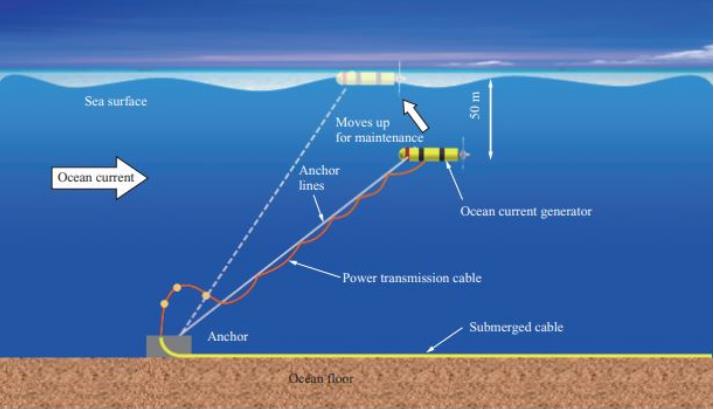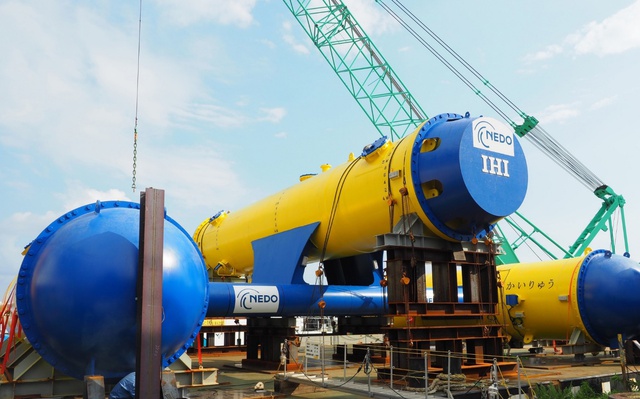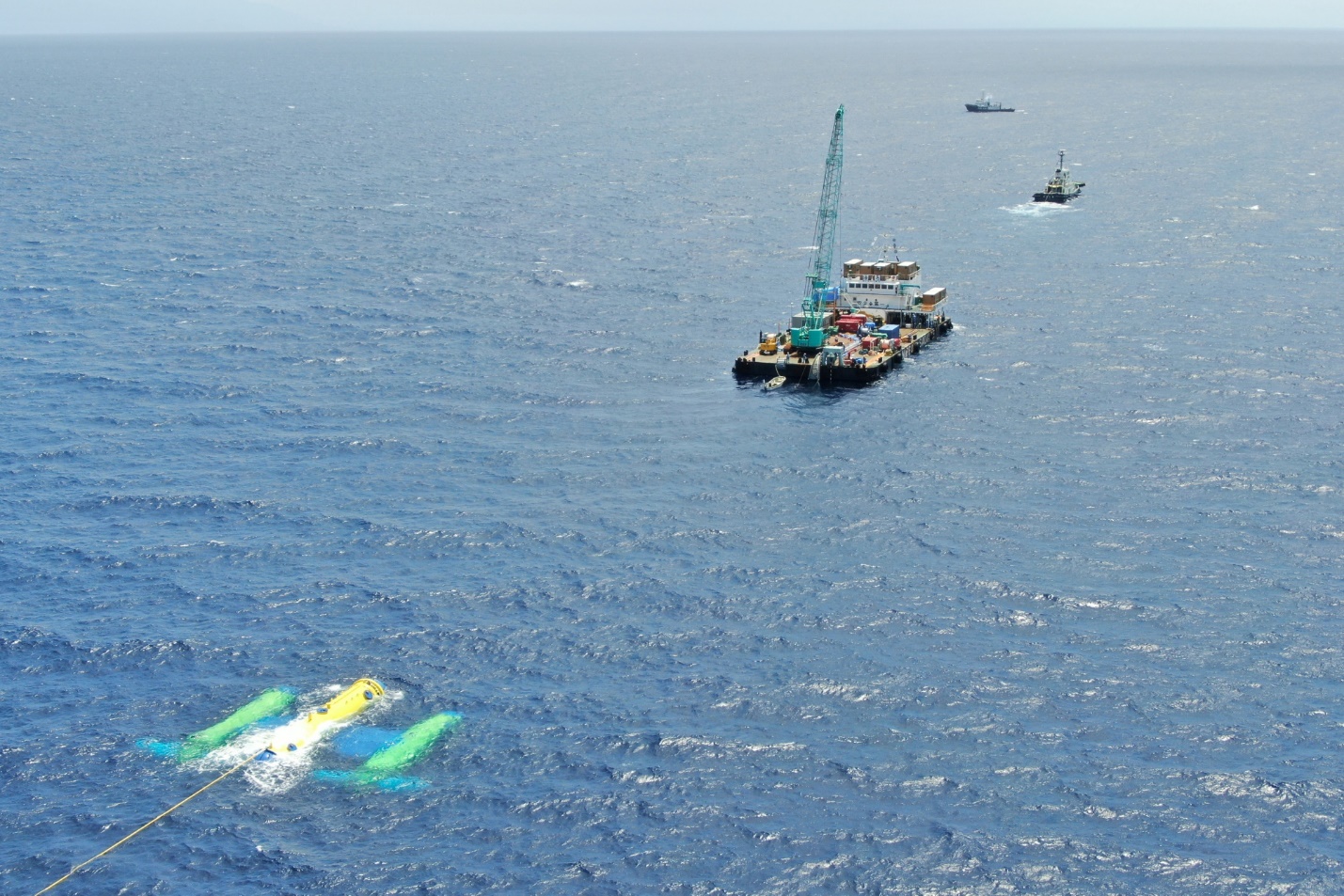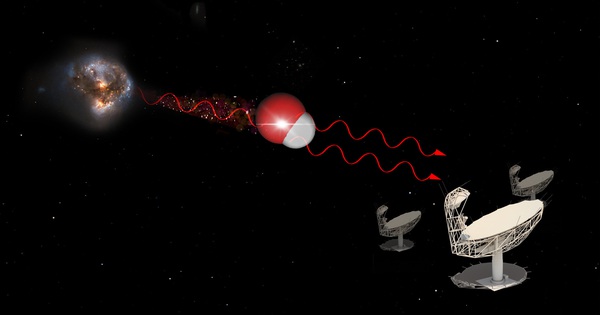Deep in the ocean, a source of energy just waiting to be tapped, opens the dream of eternal energy
New breakthrough of green energy
Japan is a country thirsty for electricity and heavily dependent on fossil fuels. Therefore, Japan is constantly looking for new and sustainable energy sources. The country has successfully tested a system that can provide a stable, continuous form of renewable energy, independent of the wind or the sun.
For more than a decade, heavy machinery manufacturer IHI Corp. of Japan has developed a turbine that operates on the seabed to harness energy from deep ocean currents, turning it into a stable and sustainable source of electricity.
The giant machine resembles an airplane with two turbine blades that rotate in opposite directions like a jet. A centrally located “fuselage” houses the buoyancy control system. The prototype, called Kairyu, weighed 330 tons and was built to anchor on the seabed at a depth of 30-50 meters.
In commercial production, the company’s tentative plan is to place the turbines in the Kuroshio Current, one of the world’s strongest currents. This current flows along the east coast of Japan. Electricity will be transmitted through cables under the sea.
Ken Takagi, professor of ocean technology policy at the Graduate School of Frontier Sciences, said: “Japan has an advantage in terms of accessibility to ocean currents. Wind power is more in line with Europe in terms of currents. geographically, where it is influenced by the westerly winds and is located at higher latitudes”.
Japan’s New Energy and Industrial Technology Development Organization (NEDO) estimates the Kuroshio Current can generate up to 200 gigawatts – about 60% of Japan’s current electricity generation capacity.

The system harnesses energy from ocean currents.
Harnessing energy from the sea
Like other countries, Japan’s share of renewable energy investment has shifted from nuclear power to wind and solar power, especially after the Fukushima nuclear disaster.
Japan is the third largest solar power producer in the world and is investing heavily in offshore wind. But harnessing ocean currents can provide the basic electricity needed to reduce the need for energy storage or fossil fuel use.
The advantage of ocean currents is stability. Flow has little variation in speed and direction, resulting in a power factor of 50-70%. This is a measure of how often the system is producing. Thus, the coefficient of ocean currents is higher than that of 29% for land wind and 15% for solar energy.
An important factor in the efficiency of the turbine is its location where the currents are strong enough to generate electricity. The sea where the turbine is located must also be a place where there are not too many boats for safe installation and maintenance.
In February, IHI with NEDO completed a 3-year study on the technology. The team tested the system in the waters around the Tokara Islands in southwestern Japan. They towed Kairyu with another ship to create an artificial current.
Tests have demonstrated that the prototype can generate a steady power of about 100 kilowatts. The company now plans to scale up the full 2-megawatt system that could go into commercial operation by 2030 or later.

Like other advanced maritime nations, Japan is exploring various ways to harness energy from the sea, including tidal, wave and ocean thermal energy conversion (OTEC) energy, mining difference in temperature between the surface and the deep ocean.
Mitsui OSK Lines Ltd. invested in UK-based Bombora Wave Power to explore the potential of this technology in Japan and Europe. According to Yasuo Suzuki, director of the marketing department, the company is also promoting OTEC and started operating a 100 kW facility in Okinawa in April.
Kyushu Electric’s renewable energy unit, Kyuden Mirai Energy, began a 650 million yen ($5.1 million) feasibility test this year to produce 1 MW of tidal power around the Goto Islands. The government this month also proposed changes to offshore wind energy auctions that could speed development.
Among marine energy technologies, the most rapidly advancing in the direction of cost effectiveness is tidal energy. “The technology has come a long way and it certainly works,” said Angus McCrone, former chief editor of BloombergNEF and marine energy analyst.
Scotland-based Orbital Marine Power is one of a number of companies building tidal systems around Orkney, the location of the European Maritime Energy Centre. Others include SIMEC Atlantis Energy’s MeyGen and California-based Aquantis, which reportedly plan to begin testing the tidal system there next year.
Although tidal currents do not flow continuously for 24 hours, they tend to be stronger than deep ocean currents. The Kuroshio Current flows at a speed of 1 to 1.5 meters per second. Some tidal currents have a speed of 3 meters per second. McCrone said: “The biggest problem for ocean current turbines is whether they can produce a device that generates energy economically from currents that are not too strong.“.
Ocean Energy Systems, an intergovernmental partnership established by the International Energy Agency (IEA), sees the potential to deploy more than 300 gigawatts of ocean energy globally by 2050.
However, the potential for ocean energy depends on location, taking into account the strength of the currents, access to electricity grids or markets, maintenance costs, transportation, marine life, and other factors. other factor.

Photo: IHI Corp/NEDO
Dream of eternal energy
In Japan, wave energy is moderate and unstable throughout the year, while areas with strong tidal currents often have high discharges, Takagi said. And OTEC is more suitable for tropical regions where the temperature background is higher. One of the advantages of deep ocean currents, the IHI says, is that it doesn’t restrict the movement of ships.
However, the Japanese company still has a long way to go. Compared with onshore vehicles, the installation of underwater systems is much more complicated. “Unlike Europe, which has a long history of oil exploration in the North Sea, Japan has very little experience with offshore construction. There are huge technical challenges to building a system,” said Takagi. strong enough to withstand the harsh conditions of deep ocean currents and to reduce maintenance costs”.
He said: “Japan is not so lucky in terms of alternative energy sources. People may say this is just a dream, but we need to do everything we can to achieve zero carbon emissions.“.
With the cost of wind and solar power falling, IHI also needs to demonstrate the cost competitiveness of the ocean current project as a whole. IHI aims to generate electricity at 20 yen/kilowatt hour from large-scale deployment. This is still higher than around 17 yen for solar and 12-16 yen for offshore wind.
IHI also said it conducted an environmental assessment prior to the project’s launch and will use the test results to look at impacts on the marine environment and the fishing industry.
If successful on a large scale, deep ocean currents could play an important role in supporting the supply of green energy in the global effort to phase out fossil fuels. IHI’s work can help Japanese engineering take a leading role with government support, McCrone said.
He argues that the IHI must make a convincing argument that “Japan can benefit from being a technology leader in this area“.
at Blogtuan.info – Source: genk.vn – Read the original article here



